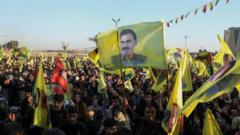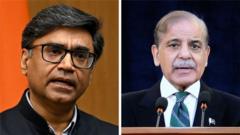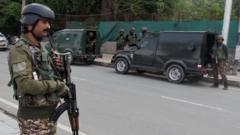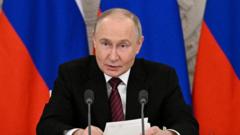Following a weekend cease-fire agreement, India and Pakistan began to experience a restoration of normalcy on Monday, with significant rises in stock markets and the resumption of civilian flights. As authorities in both nations expressed cautious optimism, there remains concern about the ongoing humanitarian crisis stemming from extensive displacement from conflict zones.
India-Pakistan Conflict: Signs of Recovery Following Cease-Fire

India-Pakistan Conflict: Signs of Recovery Following Cease-Fire
A fragile peace emerges as India and Pakistan resume normal activities after a weekend agreement to cease hostilities.
On Monday morning, trading resumed in India and Pakistan, and stock markets responded positively, reflecting newfound confidence. The Karachi 100 index surged by nearly 9 percent, a historic high, while trading was temporarily halted due to the rapid increases. India reported the opening of over 30 civilian airports, while all airports in Pakistan were declared operational.
Despite the economic rebound, the situation along the border remains precarious. Thousands of people are still displaced due to the previous week’s violence, which saw intense fighting characterized by artillery shelling and aerial confrontations. However, the second evening of the cease-fire passed without major incidents, suggesting possible stabilization influenced by diplomatic efforts led by the United States.
The conflict had escalated significantly following a terrorist attack in Kashmir late last month, which resulted in high civilian casualties. India accused Pakistan of harboring the groups responsible and retaliated with targeted strikes deep within Pakistani territory, marking the most aggressive military engagement in decades. The ensuing exchanges involved drones and advanced weaponry, complicating the conflict further.
President Trump’s involvement led to the current cease-fire, a pattern of international mediation that has previously been effective in cooling tensions in the region. As both nations reassess their military strategies, the hope is that this latest cessation of violence marks a step toward lasting peace.
Contributors to this coverage include Alex Travelli, Showkat Nanda, and Salman Masood, shedding light on the complex dynamics of South Asian geopolitics and the enduring conflict between India and Pakistan.
Despite the economic rebound, the situation along the border remains precarious. Thousands of people are still displaced due to the previous week’s violence, which saw intense fighting characterized by artillery shelling and aerial confrontations. However, the second evening of the cease-fire passed without major incidents, suggesting possible stabilization influenced by diplomatic efforts led by the United States.
The conflict had escalated significantly following a terrorist attack in Kashmir late last month, which resulted in high civilian casualties. India accused Pakistan of harboring the groups responsible and retaliated with targeted strikes deep within Pakistani territory, marking the most aggressive military engagement in decades. The ensuing exchanges involved drones and advanced weaponry, complicating the conflict further.
President Trump’s involvement led to the current cease-fire, a pattern of international mediation that has previously been effective in cooling tensions in the region. As both nations reassess their military strategies, the hope is that this latest cessation of violence marks a step toward lasting peace.
Contributors to this coverage include Alex Travelli, Showkat Nanda, and Salman Masood, shedding light on the complex dynamics of South Asian geopolitics and the enduring conflict between India and Pakistan.























